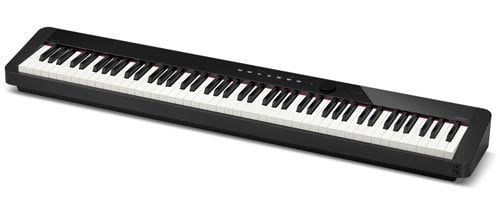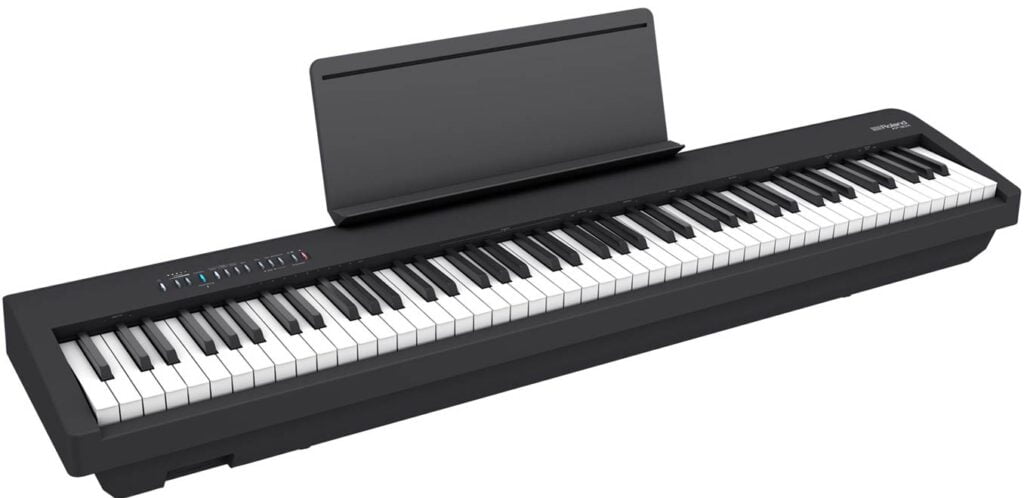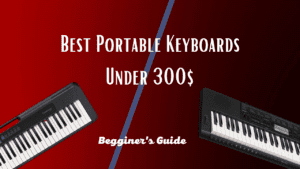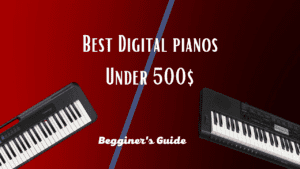Musical endeavors can be pricey – but it doesn’t have to be! The digital piano is an instrument for aspiring musicians that is more affordable than ever. It is easy to move and has great sound, without costing too much. This guide will provide the best knowledge on the best digital pianos under $700.

We will cover key features to look out for. These include: number of keys, touch sensitivity and extras like a metronome or instructional capabilities. We will also give our top picks.
We understand features are important. We want you to get the most out of your instrument as well! Our list of recommended models have all the necessary features at a fair price. They also have robust sound and a great playing experience.
Whether you want to refresh or upgrade – this guide can help inform your purchase and get maximum satisfaction from your new instrument.
This article is here to explore the many digital pianos in the market. We’ll discuss the best qualities at $700 or less. We’ll compare makes and models, and show which have great sound quality, versatility, and value. We’ll think about features like polyphony, audio effects, and other sound options. So, viewers get the best advice on getting an affordable digital piano that meets their expectations.
We hope this article provides experienced and novice musicians with valuable information and guidance. So they can find a digital piano that fits their budget and still delivers quality performance.
The digital piano market is huge and always evolving. Many features and quality levels are offered at different prices. It can be tough to pick the right instrument at the right cost. But, with $700 or less, finding a digital piano that meets both quality and affordability criteria is possible. This is great for those shoppers on a budget!
A digital piano under $700 might not have the same sound quality or features as pricier models, but it can still provide an enjoyable experience. Shopping at this price range allows buyers to compare different brands before selecting the best one for them.
Just because a piano looks less expensive doesn’t mean it’s the right one – researching each instrument’s qualities is essential. Consider polyphony, touch response sensitivity, and built-in rhythm capabilities when deciding which model best suits your needs and wallet.
When buying an affordable and high-quality digital piano, think about all relevant factors like size, weight, sound, and personal preferences. Doing so helps buyers make music without overspending!
Explanation of the four models that will be reviewed
This review looks at four digital pianos under $700. We’ll discuss the Roland FP-30X, Casio PX-S1100, Yamaha P-125 and Kawai ES120.
- Roland FP-30X is an 88-key digital piano with weighted keys. It provides 24 sounds, a dual/layer function and rhythm accompaniment. You can also connect external devices via Bluetooth.
- Casio PX-S1100 has 88 graded hammer action standard (GHS) keys. It has 17 voices, USB MIDI, 512KB of storage and acoustic quality reverb.
- Yamaha P-125 is 88 keys with counterweights. It has 19 voices, Virtual Resonance Modeling (VRM), Pure CF sound engine and Sophisticated Rhythm feature. It is plug & play for external devices.
- Kawai ES120 has 88 premium Hammer Action IVF Keys. It has 53 noises samples, headphone jacks, dual language support and internal tuning capabilities.
I. Roland FP-30X
The Roland FP-30X is one of the most popular digital pianos available. It has Roland’s PHA-4 Standard Keyboard with Escapement and Ivory Feel for a realistic playing sensation. Dual headphone jacks, built-in audio recorder, Bluetooth Connectivity, and Damper Resonance are also included.
You’ll get access to over 300 realistically sampled sounds such as grand and electric pianos. You can also create custom sound packs or upload new sound packs online. Beginners get an onboard rhythm coach to help refine accuracy and timing. Advanced players can use two track recording to record two parts simultaneously. All of this at under $700 makes the Roland FP-30X a great choice.

Shopping for a digital piano has many factors to consider, such as sound quality, weight and size, key and pedal feel, features and functions. The four digital pianos mentioned in this article are high-quality products offered on a budget.
- Roland FP-30X is an 88 key digital piano with Ivory Feel-G keyboard and Responsive Hammer Compact (RHC) action. It has superior sound quality, thanks to Roland’s SuperNATURAL Piano Modeling technology and Acoustic Projection speakers. It also has a powerful stereo amplifier. The unit size is 1384 x 295 x 152mm. It has Bluetooth Midi technology and apps like Piano Every Day, USB Interface audio/Midi ports, and line output to connect to external PA systems or stereo amplifiers/speakers.
Pros and Cons
Pros
- Excellent keyboard with Ivory feel keys and Escapement: The keyboard of this piano is exceptional with the Ivory feel keys and Escapement feature. These features provide a realistic feel and response to the keys, making it easier for pianists to play and practice.
- Rich natural piano sound with simulated key-off and string resonance: The piano sound of this instrument is rich and natural, thanks to its simulated key-off and string resonance features. These features produce an authentic sound that closely resembles that of an acoustic piano.
- Wide selection of built-in tones (56): The piano has a wide selection of built-in tones, providing musicians with various options. With 56 built-in tones, you can experiment with different sounds and styles to create your own unique compositions.
- Powerful speaker system: The speaker system of this piano is powerful and produces high-quality sound. It is designed to fill a room with sound, making it suitable for performances or rehearsals.
- Great connectivity (Bluetooth MIDI & Audio): The piano has great connectivity features, including Bluetooth MIDI and Audio. This makes connecting to other devices and integrating with various music software is easy.
Cons
- Slightly heavier than its competitors: The piano is slightly heavier than its competitors, which can make it less portable.
- Limited layering and recording capabilities: The piano has limited layering and recording capabilities, which can be a drawback for musicians who want to create complex compositions.
- No rhythms (without the app): The piano does not have built-in rhythms, which means that you need to use the app to access this feature.
[su_button url=”https://digitalkeyboardpiano.com/roland-fp-30x-review/” target=”blank” style=”stroked” size=”7″ center=”yes” radius=”0″ icon=”icon: thumbs-o-up” text_shadow=”0px 0px 0px #000000″]Full Review[/su_button]
II. Casio PX-S1100
The Casio PX-S1100 is a great digital piano choice for those on a tight budget. It has 88 full-sized, weighted keys – the same as most professional pianos – and takes up less space. It’s also super affordable! You get many tone options, customizability, and 192 polyphony for easy creativity. Lightweight and durable, it’s perfect for gigging musicians who don’t want to have a heavy instrument around.
The 8W+8W speaker system gives studio-quality sound and is loud enough for live shows – no PA system is required. Even amplified music festivals won’t be a problem!
The Casio PX-S1100 digital piano is an amazing pick for those who need quality and great features, but are on a budget. This lightweight and portable instrument has an 88-note graded hammer action keyboard. Its keys are full-size tri-sensors, which give an authentic piano feel. Additionally, its improved AiR sound source technology replicates acoustic piano sound with unbelievable realism. It also provides 18 modern voices and 256 from pro-audio instruments.
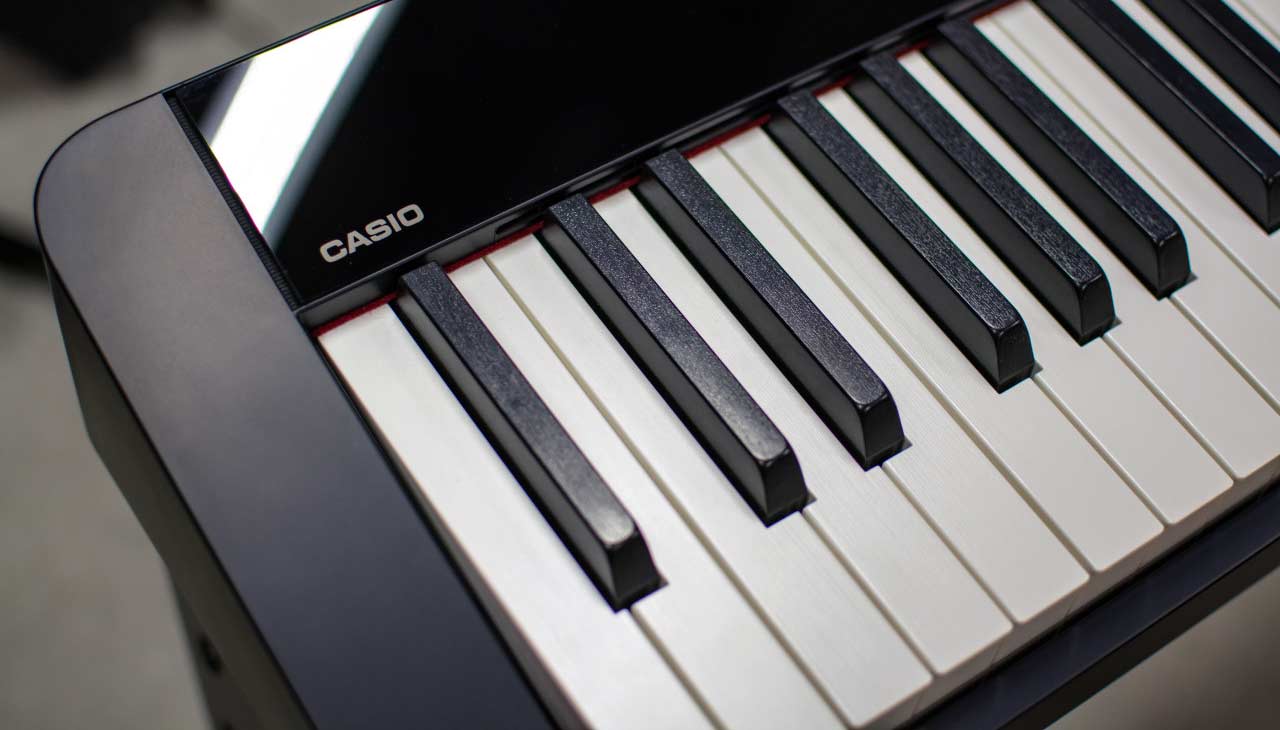
The dual, quad, and split keyboard functions make this instrument extra versatile. High resolution Reverb and Chorus effects can be combined to form 3D Ambience. This creates a deeper resonance when playing with bigger headphones or speakers. The damper resonance simulates the subtle lingering tone of a grand piano’s sustain pedal. 10 rhythms with automatic chords accompaniments and rhythm patterns can liven up performances.
The USB connectivity feature lets users record and transfer their performances directly to their computer or iPad without extra software. Plus, it has a wireless music stand for convenient storage of sheet music or books during performance. There are also two headphone jacks for private practice or duets simulations.
Pros and Cons
Pros
- The piano boasts a distinctive and forward-looking design that sets it apart from traditional models. It is also incredibly compact and lightweight, making it an ideal choice for those with limited space or who need to transport it frequently. In addition, it has the ability to operate on just six AA batteries, making it an extremely portable option.
- The nuanced and natural sound produced by this piano is another standout feature. The sound can be adjusted using several parameters, allowing for customization to suit individual preferences. Additionally, the piano has an impressive 192-note polyphony, enabling it to produce complex and rich soundscapes.
- The piano is also equipped with Bluetooth capabilities, allowing for seamless audio and MIDI connections. This feature provides enhanced flexibility for recording, composing, and performing.
Cons
- One drawback of the piano is its relatively short pivot length. This may not be an issue for beginners or those who are used to playing smaller keyboards, but experienced players may find it challenging to adjust to. Additionally, the glossy finish of the piano tends to attract fingerprints, which can be a minor inconvenience.
- Finally, the touch-based controls are not tactile, which may not be ideal for musicians who prefer physical buttons or knobs. This aspect could take some time to get used to and may not be suitable for everyone.
[su_button url=”https://digitalkeyboardpiano.com/casio-px-s1100-review/” target=”blank” style=”stroked” size=”7″ center=”yes” radius=”0″ icon=”icon: thumbs-o-up” text_shadow=”0px 0px 0px #000000″]Full Review[/su_button]
III. Yamaha P-125
Yamaha P-125 is an 88-key digital piano. It has great sound quality and dynamics, thanks to its AWM technology. Features like a resonant damper pedal and 10 instrument voices add to its appeal. Its touch sensitivity is light, which may be an issue for those wanting more control over expressiveness. But, its economical price makes up for it. Bluetooth Midi capabilities allow you to incorporate your computer into your practice.
Overall, Yamaha P-125 is an excellent choice in its price range. It’s one of the most popular digital pianos under $700.
The Yamaha P-125 is an 88-key digital piano with a lot of features. Its GHS keyboard provides a realistic feel, and synthetic ebony and ivory keys offer good playability. Plus, the keyboard has weighted action to imitate an acoustic piano.
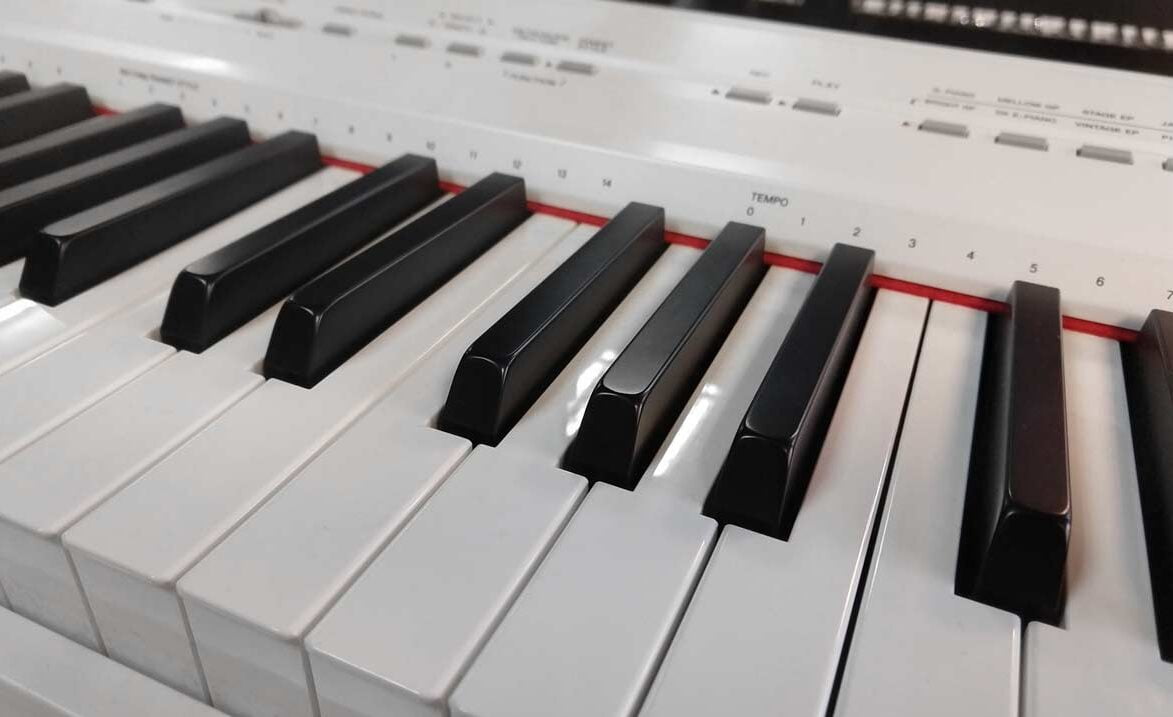
It has 16 built-in voices and 192-note polyphony, plus the Pure CF sound engine for faithful reproduction of the 9′ CFIIIS concert grand. It can connect to Smart phones or other devices via Bluetooth for wireless audio streaming from music apps.
Connectivity options include USB Midi for transfers and MIDI over USB for use with third party DAWs. It also has damper resonance for more expressive sound. Lastly, it’s compatible with the Piano Diary app for tracking progress.
Pros and Cons
Pros
- This piano is relatively compact and lightweight, making it easy to move around and store. It features a beautifully sampled Yamaha CFIIIS grand piano sound that is sure to impress even the most discerning musician. With 192-note polyphony and an excellent speaker system, this piano produces a rich and full-bodied sound.
- The piano also includes a 2-track MIDI recorder, allowing musicians to capture and playback their performances. Additionally, it features 20 built-in Accompaniment Rhythms, providing a range of musical backing options.
- Dedicated Line Out jacks and a USB Audio Interface function further enhance the piano’s versatility, allowing for seamless integration with other equipment.
Cons
- One drawback of this piano is that the key action is not very impressive. This may not be an issue for beginners or those who prioritize sound quality over playability, but more experienced players may find it lacking. Additionally, the piano does not feature Bluetooth connectivity, which may be a downside for those who prefer wireless connectivity.
- Finally, the piano has very limited sound customization options. While the pre-loaded sounds are of high quality, there is little room for tweaking or personalization, which may be a deal-breaker for some musicians.
[su_button url=”https://digitalkeyboardpiano.com/yamaha-p125-review/” target=”blank” style=”stroked” size=”7″ center=”yes” radius=”0″ icon=”icon: thumbs-o-up” text_shadow=”0px 0px 0px #000000″]Full Review[/su_button]
IV. Kawai ES120

The Kawai ES120 is a top-notch digital piano in the under $700 range. It features stunning sound sampling and class-leading Harmonic ImagingXL Technology for a realistic, immersive grand piano experience. Plus, the 88-note graded hammer action keyboard gives you great playability.
Onboard, you’ll find features that help inspire your compositions and performances. It’s got Bluetooth audio/MIDI support and a built-in MIDI recorder. So it’s ideal for live performance or recording in the studio.
The Kawai ES120 is an unbeatable package for the price. It’s one of the best digital pianos under $700!
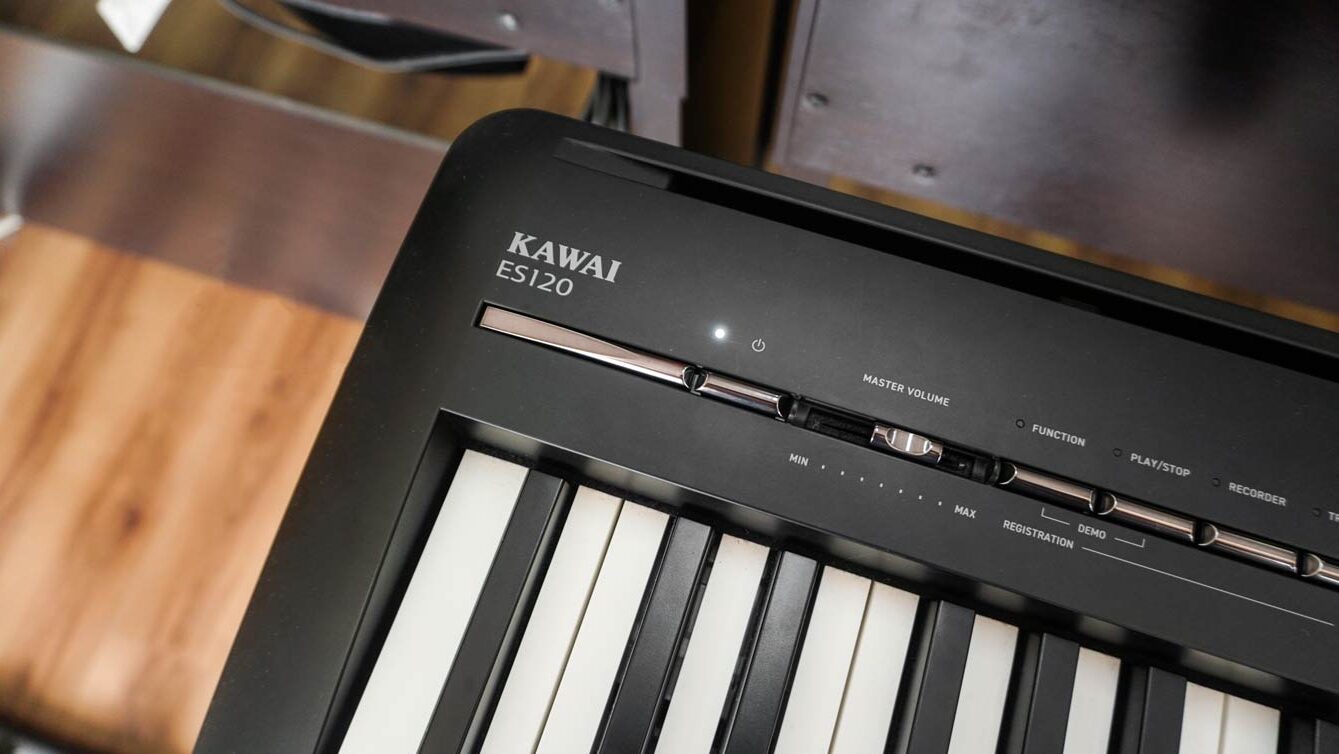
The Kawai ES120 is the perfect digital piano for budget-conscious musicians. It has 88 weighted keys, 19 sounds, and 8-track recording. Plus, Bluetooth lets you connect it to your phone or tablet. You can use the app features like IAC and Grand Feel Pedal System. Dual and Split Modes provide added versatility. Plus, 192 polyphony notes and a built-in metronome. This powerful piano won’t disappoint!
Pros and Cons
Pros
- One of the key advantages of the RHC (Responsive Hammer Compact) action on this piano is its highly responsive and effortless playability. This makes it ideal for beginners and advanced players who want to focus on their technique and expression without physical strain or limitations.
- Another notable advantage is this instrument’s wide range of high-quality piano tones. Whether you’re looking for a classic grand piano sound or something more modern, you’re sure to find a tone that suits your taste and style.
- In addition to its excellent sound quality, this piano also has impressive sound tweaking capabilities. This allows you to customize and adjust various parameters such as the reverb, chorus, and EQ to create your unique sound.
- The piano’s 192-note polyphony is also worth mentioning, as it allows for smooth and uninterrupted sound even when playing complex pieces with multiple layers.
- For those who want to incorporate drum rhythms into their playing, this piano has 100 preset drum rhythms to choose from. This adds a new dimension to your playing and allows for more creative expression.
- Furthermore, the built-in lesson books are a valuable tool for beginners who want to learn how to play the piano. With nine lesson books included, you have access to a range of exercises and pieces that will help you improve your skills.
- The piano’s Bluetooth connectivity is another advantage, as it allows you to connect to various devices and apps for even more creative possibilities.
- Lastly, the dedicated line out jacks make it easy to connect to an external sound system for live performances or recording sessions.
Cons
- One of the main disadvantages of this piano is its limited sound selection. While the available piano tones are of high quality, the lack of diversity may be a drawback for some players who want a broader range of sounds.
- Another disadvantage is the absence of a multi-track MIDI recorder. This makes it challenging to record and layer multiple tracks, limiting the creative potential of the instrument.
- Lastly, the action on this piano is on the lighter side, which may not be ideal for players who prefer a heavier touch and feel.
[su_button url=”https://digitalkeyboardpiano.com/kawai-es120-review/” target=”blank” style=”stroked” size=”7″ center=”yes” radius=”0″ icon=”icon: thumbs-o-up” text_shadow=”0px 0px 0px #000000″]Full Review[/su_button]
VI. Conclusion
Music industry’s changing. Get the best instruments at a good price. Finding a digital piano’s tough – lots of great options. Here’s our top picks for under $700.
Experienced players, get more sound quality. Beginners, find the features you want. These pianos have great sound quality and value.
Now you know enough to shop for your perfect piano!
Final recommendation for the best digital piano under $700
Researching the best digital piano under $700? Consider weight and semi-weighted action for a true piano feel. Look for extras like speakers, a sequencer, or recording capabilities. Make sure you can upgrade in future if you want more functions or sounds.
I highly recommend the Roland FP-30X digital piano over the other options listed. The FP-30X is a highly versatile and portable instrument that offers exceptional sound quality and an array of advanced features perfect for beginners and experienced players.
One of the most impressive features of the FP-30X is its SuperNATURAL Piano sound engine, which faithfully replicates the rich, nuanced sound of an acoustic piano. Additionally, the keyboard has a fully weighted, 88-note PHA-4 Standard keyboard, which provides an incredibly realistic playing experience.
The FP-30X also has Bluetooth connectivity, allowing you to stream music and connect to various music apps. This feature is especially useful for learning and practicing new songs.
Furthermore, the FP-30X has a sleek and stylish design that will complement any living space or performance venue. It is lightweight and compact, making it easy to transport and set up for gigs or performances.
Overall, the Roland FP-30X is an outstanding choice for anyone looking for a high-quality digital piano that offers exceptional sound, advanced features, and portability.
Explanation of the importance of considering sound quality, touch sensitivity, and overall value when purchasing a digital piano
When purchasing a digital piano, there are three important things to consider: sound quality, touch sensitivity, and value. The sound should be clear and adjustable. Touch sensitivity ensures each key will sound distinct. You can find digital pianos ranging from low-cost beginners’ models to more advanced ones suitable for professionals. Depending on your budget and skill level, you may want to invest in higher-end models with better-quality sound, effects, and features.
[su_tabs style=”wood”][su_tab title=”Keys” disabled=”no” anchor=”” url=”” target=”blank” class=””]
Contemporary acoustic pianos are equipped with a standard of 88 keys. On the other hand, various digital pianos and keyboards come in a range of key counts including 88, 76, 73, or 61 keys.
While 73 keys may be sufficient for playing the majority of modern compositions, approximately 99% of them, certain intricate classical pieces necessitate a complete set of 88 keys. Therefore, for those who aspire to play these more demanding pieces, an 88-key keyboard or digital piano is recommended.
[/su_tab] [su_tab title=”Action Types” disabled=”no” anchor=”” url=”” target=”blank” class=””]
There are three primary types of keyboard actions available for digital pianos, synthesizers, and portable keyboards:
1. Non-weighted action is the most common type found in organs, synthesizers, and entry-level keyboards. As the name suggests, it has no added weight or resistance to the keys.
2. Semi-weighted action is a more affordable option commonly found in portable keyboards that cost less than $300. This type of action utilizes a spring-loaded mechanism to provide additional resistance to the keys, giving them a slightly more realistic feel than non-weighted actions.
3. Fully weighted action, also known as hammer action, is designed to replicate the mechanics of an acoustic piano. Instead of springs, it employs small hammers attached to each key to mimic the mechanical movements inside a real piano. A keyboard with fully weighted hammer action keys is highly recommended if you want to play the piano.

Hammer action keys provide a similar feel to that of an acoustic piano, which is essential for developing proper finger strength and technique. This will make it easier to transition to an acoustic piano in the future, should you decide to do so.
[/su_tab] [su_tab title=”Touch Sensitivity” disabled=”no” anchor=”” url=”” target=”blank” class=””]
The touch sensitivity feature, also known as velocity sensitivity or touch response, is a crucial aspect of any keyboard or digital piano. It allows the instrument to produce varying volumes of sound based on how hard or soft the keys are played.
Fortunately, touch-sensitive keys are now widely available in most keyboards and digital pianos, costing over $150 regardless of their action type. Thus, it is no longer a significant concern when choosing a keyboard or digital piano.
What’s more important is whether the keyboard has weighted keys or not. Keyboards with fully weighted action often offer adjustable touch sensitivity, allowing you to customize it to your playing style.
[/su_tab] [su_tab title=”Polyphony” disabled=”no” anchor=”” url=”” target=”blank” class=””]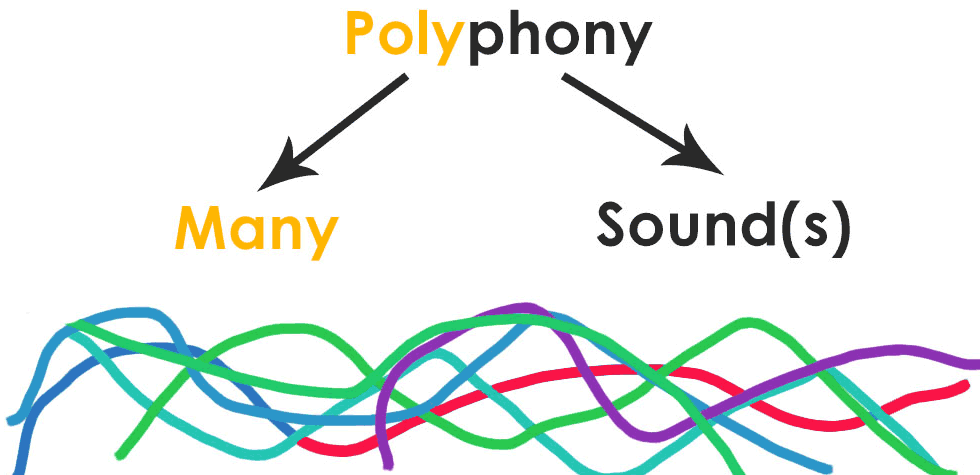
Polyphony refers to the number of notes a digital piano can produce simultaneously. Nowadays, most digital pianos offer 64, 128, 192, or 256-note polyphony.
You may wonder how a digital piano can produce 32, 64, or even 128 notes at once, given that there are only 88 keys, and we never play them all simultaneously. The reason is that many modern digital pianos use stereo samples, which require two notes for each key played.
Moreover, using the sustain pedal, sound effects (such as Reverb and Chorus), dual-mode layering, and even the metronome ticking sound can consume additional notes of polyphony.
For example, when you use the sustain pedal, the earliest played notes continue to sound while you add new ones, and the piano requires more memory to keep all the notes sounding. Another example is when you play along with a song playback or auto-accompaniment. In such cases, the piano needs polyphony for the notes you’re playing and the backing track.
When you reach the polyphony limit, the piano begins to drop the earliest played notes to free up memory for new notes, which can affect the quality and fullness of the sound. Although you’ll rarely need all 192 or 256 voices of polyphony at once, it is possible to reach 64 or even 128 note limits, particularly if you like to layer several sounds and create multi-track recordings.
For an intermediate player, it’s desirable to have 128 notes of polyphony or more.
[/su_tab] [su_tab title=”Modes” disabled=”no” anchor=”” url=”” target=”blank” class=””]
Digital pianos offer more than just the standard “Single” keyboard mode. Additional modes allow you to use two different instrument sounds or even play four-handed simultaneously. Let’s take a look at the most popular modes available on digital pianos:
Split Mode – This mode divides the keyboard into two parts, enabling you to play a different instrument sound in each section. For instance, you could play guitar with your left hand while playing the piano with your right hand simultaneously.

Dual Mode (Layering) – Dual mode lets you layer two distinct sounds to play simultaneously whenever you press a key. You could, for example, layer strings with a piano sound, or any other combination of sounds you fancy, to create new and interesting combinations.

Duo Mode (also known as Duet Play, Partner Mode, Twin Piano) – This mode divides the keyboard into two halves with identical pitch ranges, allowing two individuals to play the same notes simultaneously, including the same middle C notes.
Duet Play is particularly advantageous when used with a teacher or tutor. They can play melodies on one side of the keyboard while you play the same notes simultaneously on the other. It is a fantastic way to learn and develop your piano-playing skills.

[/su_tab] [su_tab title=”Lesson Function” disabled=”no” anchor=”” url=”” target=”blank” class=””]
Certain digital pianos feature a useful function that enables you to mute a song’s left- or right-hand part (track). This allows you to practice playing along to the remaining track that is still audible, either a preset song or one you have downloaded from the internet.
Pianos that have this function typically come equipped with a multi-track MIDI recorder. This tool records each part of a song separately, allowing you to selectively mute or solo specific parts when playing back the song. This feature is an excellent practice tool for honing your skills and improving your ability to play alongside a pre-recorded track.
[/su_tab] [su_tab title=”MIDI Recorder” disabled=”no” anchor=”” url=”” target=”blank” class=””]
A MIDI recorder is a handy tool that enables you to record and playback your own performances without requiring any additional equipment. You can use it to capture your piano playing and listen back to your recordings later.
Multi-track recording is a particularly useful feature of MIDI recorders that allows you to record multiple musical parts onto separate tracks and play them back together as a single song. This feature lets you experiment with your recordings by turning off some of the recorded tracks.
For example, you could record the right-hand part of a song on track 1, and the left-hand part on track 2 while listening to the playback of the first track. You could also create complex, multi-instrument recordings by recording several instrument parts onto separate tracks and playing them back together afterward.
It is essential to note that MIDI recording is not the recording of the actual sound of the instrument. Instead, it records the MIDI data, which consists of a sequence of notes, their length, velocity, and other parameters.
[/su_tab] [su_tab title=”Audio Recorder” disabled=”no” anchor=”” url=”” target=”blank” class=””]
Many digital pianos come equipped with a built-in audio recorder that allows you to record the actual sound of the instrument using its native samples. Once recorded, the file is typically saved to a flash drive in WAV format (Linear PCM, 16bit, 44.1 kHz, Stereo).
Using this function, you can create high-quality recordings of your playing that you can then share on social media, upload to platforms like SoundCloud, or even burn onto a CD.
Audio recordings offer a higher level of universality than MIDI recordings, as they provide you with a CD-quality audio file that can be played on most modern devices without requiring any additional software or sample libraries (VSTs) to render a MIDI recording to audio.
[/su_tab] [su_tab title=”Accompaniment” disabled=”no” anchor=”” url=”” target=”blank” class=””]
One of the most exciting features of some digital pianos is their accompaniment function, which can greatly enhance your performance by providing full backing accompaniment, including rhythm, bass, and harmony that will follow your playing and make you sound like a full band.
The accompaniment changes depending on the notes you play with your left hand, whether chords or even single notes if you don’t know the full chords. In essence, you can manage your own “band” with your left hand by specifying the chords and playing the main melody with your right hand.
Some instruments offer several accompaniment modes and allow you to specify chords using the full range of the keyboard, giving you even more flexibility and creative control over your performance.
[/su_tab] [su_tab title=”Transpose” disabled=”no” anchor=”” url=”” target=”blank” class=””]
The transpose function is a valuable feature that enables you to modify the keyboard’s pitch in semitone increments. This function is particularly useful when you want to play a piece of music in a different key without learning it in a new key and changing your finger placement.
For example, if you already know how to play a song in F major, you can transpose it to C major without learning it in the new key. Additionally, you can transpose a song written in a difficult key, such as one with many black keys, into an easier key with simpler chords while still hearing it in the original key.
The tuning function, on the other hand, allows you to fine-tune the keyboard’s pitch in increments of 0.1Hz or 0.2Hz from the standard A440 tuning. This function comes in handy when you need to match the piano’s pitch precisely to that of another instrument or recording, including an old piano.
[/su_tab] [su_tab title=”USB Type A” disabled=”no” anchor=”” url=”” target=”blank” class=””]
This particular port, also known as the USB to Device port or USB drive port, serves as a convenient tool for connecting a flash drive to the piano for quick and easy file exchange.
For instance, you can transfer MIDI songs into the piano’s internal memory for playback or rehearsal, provided the piano offers this capability. Alternatively, some piano models allow you to play back WAV and MIDI files directly from the flash drive without loading them into the piano’s internal memory.
Finally, you can store your performances recorded with the instrument onto the flash drive and load them back onto the instrument at your convenience.
[/su_tab] [su_tab title=”USB Type B” disabled=”no” anchor=”” url=”” target=”blank” class=””]
The USB port on your digital piano is commonly known as the USB to Host terminal or USB to Computer port. Its primary purpose is to facilitate the exchange of songs, files, and MIDI data between your piano and a computer or smart device using a special adapter.
By utilizing this port, you can transform your piano into a MIDI controller and gain access to a plethora of music applications like GarageBand, FlowKey, and Playground Sessions. These apps can enhance the functionality of your digital piano and provide you with a more immersive and personalized musical experience.
In addition to the applications above, numerous other programs can help you learn, compose, record, and edit music. Some piano manufacturers even offer free apps designed for their particular piano models. These applications typically provide an intuitive graphical interface that allows you to control all of the settings and functions of your instrument.
[/su_tab][/su_tabs]
No matter your budget, don’t compromise on build quality. Otherwise, you may end up with an instrument that breaks easily and produces bad sounds, making it hard to learn or play.
You Might Also Like:
Best Portable Keyboard Pianos for Under $150



